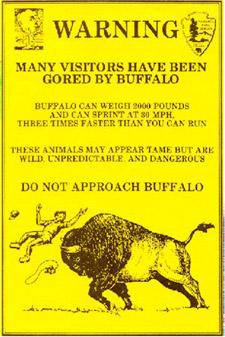Despite all the warnings passed out by Yellowstone National Park officials and rangers, from time to time visitors looking for that perfect photograph overlook the fact that the park's bison not only are wild, but can be highly temperamental. A California man discovered that in a most painful way Wednesday when looking for a close-up and the bison he was focusing on decided he wanted no part of a photo shoot.
The 55-year-old from Norco, California, came within 10 or 12 feet of the bison at the Bridge Bay Campground when the bull opted to defend his territory and charged the man, according to park officials, who did not immediately identify the man. The would-be photographer suffered a puncture wound to the upper left thigh. He was initially treated at the Lake Clinic, and then transported by ambulance to St. John’s Medical Center in Jackson, Wyoming. His injuries are not considered to be life threatening.
While this man paid the price for coming too close to the bison for a photograph, when a 50-year-old Spaniard was tossed in the air by another bison earlier this summer she was simply talking on a pay phone in the Canyon area. She was treated for minor injuries.
For those who haven't visited Yellowstone, a bull bison can stand six feet tall, weigh up to 2,000 pounds, and run at speeds up to 30 miles an hour. They often mill around such park locales as the Upper Geyser Basin at Old Faithful, the Hayden Valley, the Lamar Valley, and the Canyon area. They appear quite docile, as most of the time they are concentrating on grazing. However, bison can be dangerous at any time, park officials point out, and may be more so during the next several weeks because that time-frame marks the peak of the animals' mating season.
Park regulations require people to stay at least 25 yards away from most animals like bison and elk, and at least 100 yards away from bears and wolves at all times. Those who fail to abide by these requirements not only put themselves in danger, they may also be subject to a citation and fine.
Visitors desiring a closer look at animals are encouraged to use binoculars, a spotting scope, or the zoom lens on their still or video camera.




Comments
This happens so many times with so many animals. When I worked in Everglades a father sent his 6 year old daughter to "hold the hand" of the 12ft gator for a picture. I can't even count how many times in Shenandoah I had to tell people not to chase the bears. Sometimes that great photo just isn't worth it.
Ranger Holly
http://web.me.com/hollyberry
Before someone calls foul on the language on the pictured flier - they are bison not buffalo - it is my understanding that the language was scripted by a biology-challenged federal judge in a consent decree settling a lawsuit over a previous goring years ago. Perhaps someone else can check my facts here.
Usage is king, Anon! Buffalo and bison are equally applicable to these shaggy, be-horned medium-duty trucks. Those prescriptivists who would correct anyone who says "buffalo" can have their way just as soon as they fix the elk/moose confusion, and get everyone saying "wapiti."
Dan P., well said.
I'm sure we'll see this posted here on the snowmobile issue, but I wanted to alert people that the Interior Department has just announced their newest snowmobile and snowcoach proposal for Yellowstone.
http://www.google.com/hostednews/ap/article/ALeqM5gZpd4N1IAXu6B_2FSWUrGG...
"318 snowmobiles and 78 multi-passenger snowcoaches daily" ... based on what we saw from the NGO environmental groups last year, it seems likely they will go for that number, though I think it would leave a system in place that leaves a lot to be desired.
Jim Macdonald
The Magic of Yellowstone
Yellowstone Newspaper
Jim's Eclectic World
"get a life" you got the drift of the sign didn't you!